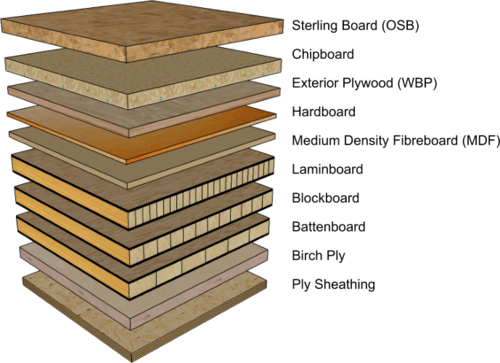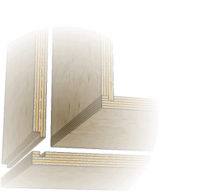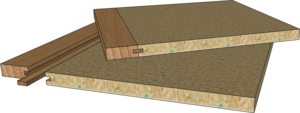Manufactured Board
From DT Online
Manufactured Boards (aka Engineered Wood or Composite Boards) comprise a range of sheet materials produced by pressing and bonding together wood particles, fibres or veneers to achieve particular characteristics - and to create a use for what would otherwise be discarded as waste.
Manufactured Boards are generally more stable, predictable and cost-effective than solid timber yet they preserve the appearance of wood. They can be worked with common woodworking tools but are most easily formed using Power Tools (e.g. Router, Biscuit Jointer), Bench Top Equipment (e.g. Mitre Saw), and Woodworking Machinery (e.g. Bandsaw, Circular Saw).
It is the development of Manufactured Boards which has revolutionised home furnishings since the 1950's by enabling the growth of Flat-Pack or Knock-Down furniture (although it should be noted that Utility Furniture in the UK during WW2 preceded this and used veneered Hardboard for panelling, since Plywood was unavailable - but the main construction was of oak or mahogany, with Mortised and pegged joints).
Plywood
- Exterior Plywood (ex. WBP) is a Plywood made by bonding together hardwood veneers, each oriented at right angles to another, with resin glue. The acronym WBP (Weather and Boil Proof) refers to the glue used to bond the layers together. Its use to distinguish exterior grade ply has now been replaced with BS EN 636:2003 Plywood - Specifications, which classifies plywood as follows:
- Class 1 : for use in dry conditions including furniture, timber frame internal and party walls.
- Class 2 : appropriate for protected external applications, but is also capable of resisting exposure to weather for short periods (e.g. during construction of timber frame external walls)
- Class 3 : is capable of withstanding exposure to weathering conditions and liquid water, or water vapour in a damp, but ventilated location.
- The durability of plywood (i.e. its resistance to decay etc.) depends not only upon the glue used, but also the type of veneer used and the quality of manufacture. Marine Ply, which is used in the marine boat building and construction industries, is Class 3 but uses only carefully selected tropical hardwood veneers and is manufactured with few voids in the core, which could hold water.
- Birch Plywood is available for both interior and exterior use and is ideal for better quality joinery or components. Aircraft Ply is used in the aviation industry and quality requirements for plywood to be used in aircraft are much more exacting than for industrial plywood in general. Thin sheets of Birch Ply are easily bent to create curved forms.
- The adhesive leaves contrasting dark gluelines against the lighter Birch veneers and these can be incorporated into a design. Consequently Birch Plywood is widely used for model making, toys, jigsaw puzzles, furniture, shelving and interiors. The uniform construction of birch plywood means that the faces and edges can easily be machined, then simply lacquered or waxed as required for interior purposes.
- Ply Sheathing is a structural Spruce Plywood suitable for interior and exterior applications where a good surface finish is not required - (i.e. flooring, lorry bodies & trailers, packaging, roofing, shuttering, hoarding, stage work, wall sheathing, temporary screening around building sites.). When used externally all faces and edges should be treated with an appropriate preserver.
Fibre Boards
- Hardboard is made from wood fibres brought together under heat and pressure to produce a thin sheet material with a uniform thickness, density and appearance and with no grain. It is easily worked with standard woodworking tools and can be securely glued or fastened with screws, staples or nails.
- Hardboard panels are rough on the underside but the top surface is smooth and can be laminated with paper overlays, plastic laminates and veneers (e.g. to be used as the back panels of cupboards).
- Tempered Hardboard has been coated with LInseed Oil then baked to make it more water resistant and durable.
- Pegboard is Tempered Hardboard with regularly spaced holes in it (e.g. used for tool-hanging hooks) and various designs of Patterned Hardboard are made with decorative shapes pierced in (e.g. used for radiator cover panels).
- Medium Density Fibreboard (MDF) is a composite panel product made by combining wood fibres with a synthetic resin and bringing them together under heat and pressure. It has a relatively hard, flat, smooth surface free of knots, rings or other blemishes. It is not as strong as plywood, tending to sag more easily under weight, and so benefits from the addition of solid wood edgings or similar if used for shelving for example (as do Particle Boards).
- MDF is mainly used indoors for a very wide range of applications, including doors, mouldings, skirting boards, internal panelling and shelving. Much of modern furniture has just a thin layer of real wood veneer over a MDF core.
Safety Point! The HSE advises that the health effects of MDF dust are similar to those of ordinary wood dust. The particles are bound with formaldehyde resin but the amount used in MDF since the 1990's has been reduced. According to the HSE, therefore, effective control of MDF dust, combined with good natural ventilation, should provide adequate control for any formaldehyde vapour in that dust.
Particle Boards
- Chipboard is made from wood chips, shavings and sawdust which is mixed with a resin adhesive then pressed and extruded into boards. It is not suitable for exterior use and is low strength but has a good surface finish and is dimensionally stable.
- Chipboard has had a major influence of the design of interior and flat-pack furniture - and especially kichen units since the 1950's. In these applications, it is finished by being veneered or combined with a plastic Laminate surface and has led to the development of a wide range of Knock-Down(KD) Fittings
- Sterling Board (aka Oriented Strand Board (OSB) ) is made of flakes of wood which are compressed and bonded together with a waterproof resin adhesive. It has a poor surface finish but is weather-resistant (but edges should be sealed if exposed to the elements)
- OSB is cheaper than Plywood and a good option for structural applications such as sheathing timber frames in buildings, shuttering for pouring concrete and shed roofs for example.
Blockboards
- Blockboard is made up of a core of softwood strips placed edge to edge and sandwiched between veneers of hardwood. Blockboard is intended for interior use only (e.g. to make shelves, doors, panelling and partitions). When used for doors or tables, it is important to ensure that the core runs lengthways in order to achieve maximum strength.
- Laminboard is a higher-grade variant of Blockboard in which the central core consists of many thinner 5-8mm battens arranged 'on edge'.
- Battenboard is very similar to Blockboard but has wider strips of softwood to form the core and is considered to be of lower quality than Blockboard.
Note: DT Online advises that most Manufactured Boards are most successfully worked with Machine Tools and Portable Power Tools.


